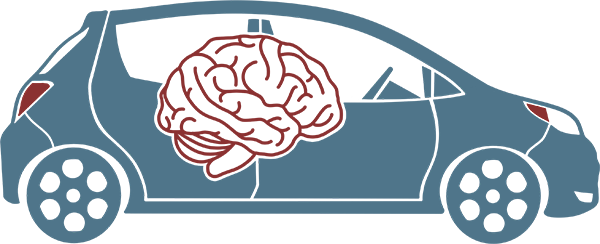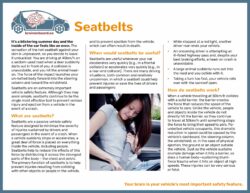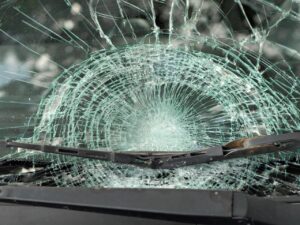Seatbelts
It’s a blistering summer day and the inside of the car feels like an oven. The sensation of the hot seatbelt against your skin is unpleasant, so you decide to leave it unbuckled. You are driving at 40km/h on a seldom-used road when a deer suddenly darts out in front of you. A collision is unavoidable, and you hit the animal head-on. The force of the impact launches your un-belted body forward into the steering column and toward the windshield.
Seatbelts are an extremely important vehicle safety feature. Although they may seem simple, seatbelts continue to be the single most effective tool to prevent serious injury and ejection from a vehicle in the event of a crash.
What are seatbelts?
Seatbelts are a passive vehicle safety feature designed to minimize the severity of injuries sustained by drivers and passengers in the event of a crash. When a vehicle suddenly stops or accelerates, a great deal of force is placed on everything inside the vehicle, including people. Seatbelts help to reduce the effects of this force by distributing it across the strongest parts of the body – the chest and pelvis. The primary function of seatbelts is to help prevent injuries resulting from colliding with other objects or people in the vehicle, and to prevent ejection from the vehicle, which can often result in death.
When would seatbelts be useful?
Seatbelts are useful whenever your car decelerates very quickly (e.g., in a frontal collision) or accelerates very quickly (e.g., in a rear-end collision). There are many driving situations, both common and relatively uncommon, in which a seatbelt could help prevent injuries or save the lives of drivers and passengers:
- While stopped at a red light, another driver rear-ends your vehicle.
- An oncoming driver is attempting an ill-fated highway pass and, despite your best braking efforts, a head-on crash is unavoidable.
- A large animal suddenly runs out into the road and you collide with it.
- Taking a turn too fast, your vehicle rolls over with the sunroof open.
How do seatbelts work?
When a vehicle travelling at 50km/h collides with a solid barrier, the barrier creates the force that reduces the speed of the vehicle to zero. Unlike the vehicle, people and objects inside the vehicle do not directly hit the barrier, so they continue to travel at 50km/h until something stops the force to bring their speed to zero. For unbelted vehicle occupants, this dramatic reduction in speed could be caused by the vehicle’s dashboard, the steering column, the windshield, or, in the case of physical ejection, the ground or an object outside the vehicle. Just as the vehicle sustains crumple damage when it hits a barrier, so does a human body—sustaining blunt-force trauma when it hits an object at high speeds. These injuries can be very serious or fatal.
Seatbelts help to spread the forces that result from a sudden stop across the strongest parts of the body. After a hard stop, which sends a person’s body forward, the seatbelt locks thereby preventing a collision with the steering column or a total ejection from the vehicle. With a lap-shoulder belt (i.e., a belt that crosses across the lap and the chest), the forces are spread across the strongest parts of the body: the pelvis and chest.
How effective are seatbelts at reducing injuries?
Seatbelts continue to be the single most effective safety measure to reduce serious and fatal injuries in the event of a collision. When coupled with airbags, the effectiveness of seatbelts in preventing serious injury during a collision increases (NHTSA, 2009).
In 2023, Transport Canada revealed 32% of fatally injured motor vehicle occupants and 13% of seriously injured occupants were unbelted at the time of the collision (Transport Canada, 2025). According to Transport Canada, 97.2% of front-seat occupants wear their seatbelts across Canada (Transport Canada, 2020). In addition, properly worn seat belts can lower the likelihood of fatality in a crash by nearly half (47%) (Transport Canada, 2020). The number of lives saved would undoubtedly increase if more road users wore their seatbelts. Overall, it is estimated that seatbelts reduce the risk of death in the event of a crash by 45% if sitting in the front seat of a passenger car and by 60% if sitting in the front seat of a light truck (Kahane, 2015).
Could seatbelts cause injuries?
Depending on the force of the collision, seatbelts can cause comparatively minor injuries to belted vehicle occupants. As a crash becomes more forceful, belted drivers and passengers are propelled forward at a faster speed. In these cases, it takes more force from the seatbelt to counteract the force of the propulsion, and this can result in discomfort and external bruising. However, the extent of the injuries sustained by unbelted vehicle occupants would be much more serious.
Seatbelts are currently complemented with a variety of other safety systems, and more sophisticated interior systems are currently being designed. In the near future, drivers can expect significant safety advances that reduce injuries in the event of a crash, including the following:
Airbags: Most vehicles have at least frontal airbags, and many have side-impact airbags and back-seat airbags. When used in combination with seatbelts, airbags help to further reduce the severity of injuries in a crash (Afifi, 2015; IIHS, 2023).
Collapsible steering columns: Standard steering columns are rigid, and can cause serious injury to drivers who collide with them. Collapsible steering columns are more flexible, thus they are able to absorb some of the force of the impact with the driver, preventing further injuries.
Vehicle crumple zones: In a frontal-impact crash, some of the force of the crash is absorbed by the vehicle via crumpling. If vehicles did not crumple, all the force of the crash would be felt by vehicle occupants. Crumpling allows some of this force to be absorbed by the vehicle itself so that drivers and passengers do not bear the brunt of the entire crash force.
Windshields: In the event of a crash, the safest place for drivers and passengers to be is in the vehicle. Windshields help prevent ejection and roof collapse in the event of a rollover. Drivers are strongly encouraged to maintain their windshield, as cracks can reduce its overall integrity and prevent the windshield from providing the most protection.
Whiplash prevention systems/smart head restraint: Whiplash occurs when the head suddenly accelerates faster than the torso. Whiplash is common after rear-end collisions, and can result in long-lasting painful symptoms. A properly positioned head restraint can help prevent or reduce the severity of whiplash; however, studies suggest the majority of front-seat occupants do not adjust the head restraint properly (Acar et al., 2007; IIHS, 2019; Farmer et al., 1999). Whiplash prevention systems (also known as smart head restraints or active head restraints (AHR)) automatically adjust the head restraint to the proper position. Research shows when AHR is in use in a rear-end crash, 35.6% fewer occupants sustain a moderate head injury (Parenteau et al., 2020). Generally, compared to conventional head restraints, the use of AHR reduces head and upper neck injuries in a crash (Parenteau et al., 2020). A head restraint should be placed at least as high as the centre of gravity for the head (IIHS, 2019). People differ in size and vehicles are equipped with different types of head restraints; therefore, adjust the restraint to as high as it will go on your head. The restraint should also be placed close to the back of the head, ideally approximately 5 cm from the head and not more than 10 cm.
Do seatbelts have any limitations?
Yes. Like other vehicle safety systems, drivers must use their seatbelt appropriately and drive safely in order to gain the most benefit from wearing it. Using the seatbelt appropriately means wearing it so it fits snugly across the hips, chest, and shoulder. Driving safely with the seatbelt involves understanding the functional limits of seatbelts and refraining from engaging in dangerous driving behaviours that make crashes more likely, for example, speeding, distracted driving, and fatigued driving.
Seatbelts must be fitted properly in order for them to work. In fact, seatbelts that are
used improperly are not only less effective at reducing the severity of injuries sustained in a crash, but could also cause further injury that otherwise would not have been sustained if the seatbelt had been worn properly. For instance, tucking the shoulder belt under the arm will have this effect: in a crash, the upper body will bend forward at the lap causing the head to hit the inside of the vehicle. Since the force of the crash is mostly isolated to the lap, the belt will press into the abdomen causing potentially fatal internal injuries (Biswas, 2014). With regard to proper seatbelt use, additional precautions must be taken by pregnant women and children under 12. For further information about proper seatbelt use, visit Transport Canada’s website at www.tc.gc.ca.
Seatbelts cannot prevent crashes from occurring, so the onus is on drivers to remain attentive and aware in order to help prevent crashes. Certain driver behaviours can make crashes more likely and put undue strain on seatbelts in the event of a crash. In particular, excessive speed can affect a seatbelt’s performance by making it more difficult for the belt to prevent front-seat occupants from colliding with the vehicle interior. Excessive speed can also exaggerate any injuries that belted vehicle occupants sustain from the seatbelt itself. For example, the higher the speed, the more the lap belt will press into the abdomen in the event of a collision.
In addition, studies have revealed that drinking drivers are both more likely to be involved in crashes and also less likely to wear a seatbelt (Williams & Shabanova, 2002). In a study of trauma patients, the probability of using a seatbelt was inversely related to the number of drinks that subjects had consumed (Ball et al., 2005). Similarly, a study from Norway revealed that 64.6% of drinking drivers who were killed had not been wearing seatbelts (Bogstrand et al., 2015). The combination of elevated crash risk and lowered seatbelt use greatly increases the likelihood of sustaining serious or fatal injuries. One reason why drinking drivers are less likely to use their seatbelt may be that alcohol impairment affects the ability to use good judgment and make smart decisions, one of which is to wear a seatbelt.
How many road users wear their seatbelts?
Seatbelt usage was an issue of primary concern for several decades in the road safety community. Large-scale efforts were made to help educate drivers on the benefits of seatbelts and to encourage them to wear them. In addition, in the mid-1980s provincial and territorial governments began mandating the use of seatbelts. Every province and territory in Canada now has a primary seatbelt law, which means that law enforcement officers can pull over a driver because of the non-use of a seatbelt (secondary laws, on the other hand, require that some other infraction be the cause of the traffic stop). Fines are issued and, in parts of Canada, demerit points are also issued for the non-use of seatbelts. In 1976 Ontario was the first province to legislate that all passengers over the age of 15 must wear a seatbelt.
As a result of these legal and social measures, seatbelt use in Canada among drivers, front-seat passengers, and back-seat passengers has been high for several years. Transport Canada reported 97.5% of Canadians use their seatbelts (Transport Canada, 2022). The province with the highest seatbelt use is Prince Edward Island, where 98.7% of vehicle occupants used their seatbelts in 2020 (Transport Canada, 2022). A Traffic Injury Research Foundation (Woods-Fry et al., 2021) Road Safety Monitor poll revealed just 4.2% of Canadians admitted they were less likely to wear their seatbelt while driving during the COVID-19 pandemic, as compared to before the pandemic. The majority of drivers (74.9%) reported there was no change in this behaviour and 20.9% were more likely to wear their seatbelts during the pandemic as compared to before COVID-19.
Where can I find more information?
Transport Canada has been conducting research on seatbelt use and has published several fact sheets and reports on the rate of seatbelt use in Canada, trends among Canadian seatbelt users, and proper seatbelt use. These publications can be accessed at www.tc.gc.ca.
In addition, the National Highway Traffic Safety Administration (NHTSA) in the United States has conducted research on topics similar to Transport Canada with regard to seatbelt use. NHTSA’s research is located at www.nhtsa.gov.
Visit brainonboard.ca/program-resources/references for a full list of references.



